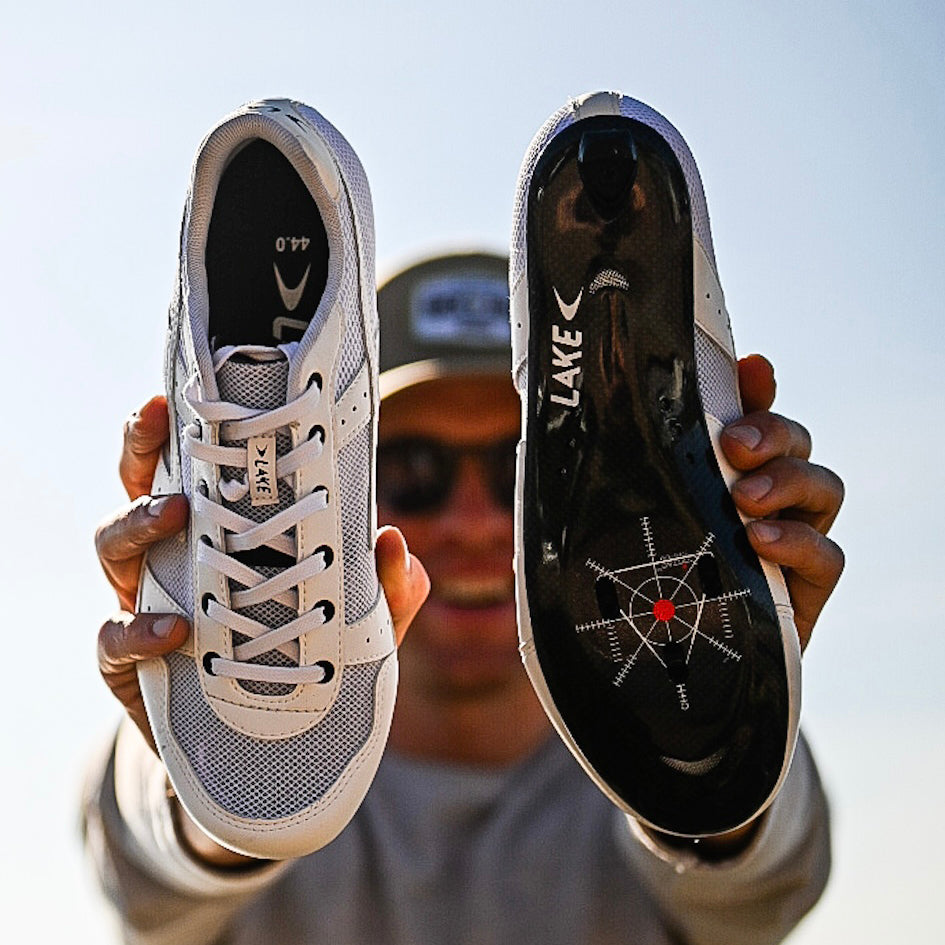Cleat Positioning - Getting set to cycle

Those of us that use clipless pedals will at some time, have gone through the complexity of releasing ourselves correctly from the bike. There was an occasion many years ago, when I first used them, that I couldn’t release in time and ended up falling into a hedge – much to the amusement of my fellow riders! It’s a common theme for cycling clubs, when the group stops at traffic lights, seeing who will fall over before being able to unclip. However, there are lots of benefits to riding clipless; which is why we at Lake produce cycling shoes that allow riders to do so.
The obvious benefits from clipless riding are the stability of the foot and the power transfer. Riding flat pedals is a great way to learn to control the bike, especially in mountain biking. However, each time that the bike hits a bump, and on many other occasions when the foot disengages with the pedal, you lose that valuable control and power. In terms of power transfer, when the foot on a flat pedal has pushed the pedal downwards, it almost becomes redundant in powering the crank back upwards to continue the motion. Vital power is lost, even if your pedal action on flats is superb. Quite simply, the pedal and the foot aren’t fully connected.

Setting the cleats
On road bikes in particular, the use of clipless pedals allows racing cyclists that extra control and power needed. Having the pedals and cleats set up correctly though, is vitally important. When you think about it, the pedal is attached to the foot; the foot is attached to the leg and the knee; and the knee is attached to the upper leg and the hips. Lots of issues can arise along this chain if the pedals and cleats aren’t set up for your own individual needs. At any of these points, you might feel pain or discomfort.
Our individuality is abundantly clear when we walk. Our feet may point in different directions, albeit only be a minor fraction. How our left and right foot work naturally is important when we then lock these feet onto the pedals with cleats; and that’s why cleats come with different float options, and with shims – to help you to get the right cleat positioning and float for your own cycling needs. Doing so, reduces the likelihood of pain and discomfort along the ankle, knee and hip chain when riding.
Fundamentally, there are five main ways you can adjust your cleats: forward and backwards, side-to-side, rotationally, using the float, and finally, the pedal tension. A small degree of float is always useful for cyclists, allowing your knees to bend and flex in a natural way during the pedal action. Manufacturers offer cleats with varying degrees of float, and visiting a bike fitting expert with one of our Lake shoe fitting partners will help you to find out which degree of float you require.
Understanding float is key to riding comfortably; a good and precise cleat float allows for a small degree of movement during pedalling, which can than help to reduce the stress on your joints. The bike fitter will work with you so that the rotation is set to allow your feet to be in a natural position when clipped into the bike. Getting it right will lead to miles of smiles on the bike, so a professional Bike Fit is worthwhile investment.

Benefit from a bike fit
Positioning your cycling cleats correctly in relation to the pedals is crucial, as we’ve stated. The bike fitting experts who work alongside Lake will check all of the necessary points for you. However, in the main, thecleat should be positioned so that the center of the pedal axis aligns with the ball of your foot (the metatarsal heads). This should help in optimising power transfer and help to reduce strain.
Fundamentally, we design cycling shoes to give you that necessary comfort and performance on the bike. However, if your cleats aren’t correctly set for your own needs, then you may need adjust the cleats. You may have been using clipless pedals for some time, even over many years. However, have you ever taken time aside to think in detail about how the cleats are set onto the sole of your Lake cycling shoes? If not, then there’s every likelihood that a visit to a Lake shoes, bike fitting partner will help you to set things up correctly, reducing the possibility of any issues and increasing your performance and efficiency on the bike. For more information about installing cleats onto your new pair of Lake cycling shoes, click the link here:https://www.lakecycling.com/pages/cleat-installation







Leave a comment